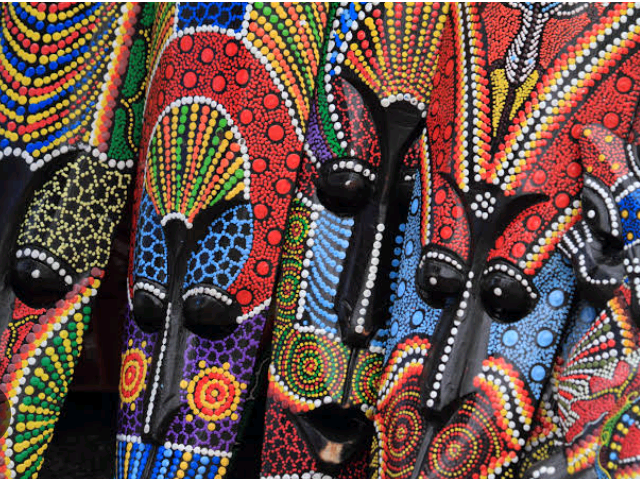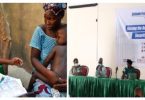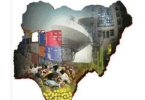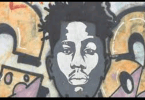Nigerian art from ancient times can only be described as ethereally beautiful, and infused with shocking, complex realism. Before contemporary Nigerian art came into being, these artworks were proof of intelligent civilizations in ancient Nigeria. They attested to the wisdom and rich creative imagination of ancient peoples that dwelt across the landscape known later as Nigeria.
Clear depictions of this complex and beautiful realism include:
- Benin and Ile-Ife bronze and clay artworks
- Nok terracotta
- Traditional masks and wood carvings from several cultures across Nigeria
- Batik and other native cloth designs indigenous to Nigeria
- Complex hair styles of many indigenous cultures
- Advanced pottery works from across several Nigerian cultures
- Calabash artworks and wood carvings from several cultures across Nigeria
- Mural artworks and paintings
- Hand-woven clothes, mats, bags, baskets, furniture pieces and home items
- Body art (Tattoos)
- Beadwork
In truth, the list of beautiful and complex art forms that have emanated from Nigeria since ancient times is awesome. To the extent that the British soldiers could not resist carting away many artworks from Benin and Ile-Ife when they came.
Ancient artists before colonial Nigeria (and many afterwards) underwent thorough training and skill acquisition from master artists of their time. All these had firmly laid the foundation for contemporary Nigerian art as we know it today.
The Scope of Nigerian Contemporary Art
So what is the scope of Nigerian contemporary art? Olawole Famule in his online article “Contemporary Art of Nigeria and its post-independence Impact” described contemporary Nigerian art as follows:
“”Also often interchangeably called Post-independence Nigerian art, Post-colonial Nigerian art, and Modern Nigerian art, Contemporary Nigerian art is a “Western-type of art,” which requires that its maker or creator receive the needed artistic skills through a formal (academic) and/or informal (workshop-oriented) art training system(s).
“Aina Onabolu, father of Modern Nigerian art, had also used the term, “new” or “true” art, to describe what he perceived as Contemporary Nigerian art.””
Thus contemporary Nigerian art began taking shape following the introduction of western education into the country by the missionaries. The teaching and learning of cultural and creative arts in schools was subsequently established by Aina Onabolu as a formal discipline.
Contemporary Nigerian Art: Notable artists that Defined the Era
We can confidently say more and more talented people are joining the ranks of praise-worthy creatives in contemporary Nigerian art. Not only that, gone are the days when Nigerian artists could barely fend for themselves in spite of their dedication.
Cultural and art shows, exhibitions, auctions and art galleries continue to expose the valuable works of many of these artists. And eager art collectors all over the world are willing to pay thousands of US Dollars or more, to have them.
Below is a curated list of the most popular and sought-after contemporary Nigerian artists whose works you should watch out for. There are others emerging at home and in the international community not mentioned here. Arguably, they are presented in the order from the top (and most experienced) creatives to the newest ones.
However, years of work put into seeking exposure and patronage for their work have gone by – especially by the most experienced ones.
- Ben Enwonwu
- Bruce Onobrakpeya
- Nike Davies-Okundaye
- Aina Onabolu
- Uche Okeke
- Yusuf Grillo
- Victor Ehikhamenor
- Victoria-Idongesit Udondian
- Etsu Ugbodaga
- Marcia Kure
- Lamidi Fakeye
- Kolade Oshinowo
- Akinola Lasekan
- Peju Alatise
- Delẹ Jegede
- David Dale
- Sam Ovraiti
- Dada Olusegun
- Nnenna Okore
- Kadara Enyeasi
- Otobong Nkanga
- Ruby Amanze
- Ade Ademola
- Oresegun Olumide
We will discuss the unique journeys of just the top 8 of them in this article.
Ben Enwonwu (1917 – 1994)
Benedict Chukwukadibia Enwonwu, a twin by birth, hailed from Onitsha, Anambra state. This renown sculptor and painter was (and still is) the most outstanding African artist of the 20th Century. History has it that his father, a titled member of the Onitsha Council Of Chiefs was an experienced sculptor. Thus Ben inherited his father’s skills and tools after his death, in addition to western education.
Ben was a graduate of the Slade School of Fine Art, University College London. He later completed his postgraduate studies in Anthropology at the University of London in 1948.
His refined works and the zeal at promoting them, practically led the entire visual arts movement from Africa to the world. From 1950 onwards, Ben took his works to art exhibitions in the USA and Europe and earned great international recognition. This prodigy of art won many awards while he was still alive.
Bruce Onobrakpeya (1932 – )
Bruce Obomeyoma Onobrakpeya is a multiple award-winning painter, sculptor and printmaker of Agbarha-Otor, Delta state origin. He graduated from the Ahmadu Bello University, Zaria; and attended other skill acquisition workshops in western Nigeria and the USA.
Bruce was inspired by the Zaria Rebels movement led by Uche Okeke while in university. Thus his later artworks explored traditional African themes: legends, myths, and folklore. He held his first-ever one-man exhibition in Ughelli, 1959. And from there, Bruce went ahead to exhibit his works in other countries (including Zimbabwe, Kenya, Italy, US, Germany, and Britain).
He set up the Bruce Onobrakpeya Foundation to train upcoming artists via workshops held in his hometown every year till date.
Nike Davies-Okundaye (1951 – )
The renowned textile artist known by the name Nike Davies-Okundaye hails from Ogidi, Kogi State. She specializes in embroidery, Batik and Adire cloth designs; and is the owner of the Nike Art Gallery in Lekki-Lagos. NIke grew up in the midst of a family of cloth-weaving and cloth-dyeing artisans, thus learning the trade. She was further exposed to traditional cloth art at Osogbo where she spent part of her growing years.
So far, Nike owns four art centers where she has been offering free training to creative artists in several categories. She has organized training workshops on traditional Nigerian textiles in Europe and the USA. Nike’s works have also been permanently displayed in museums and galleries in the USA and Britain. The mother of six is a traditional chieftaincy holder, and has several international honors to her credit.
Aina Onabolu (1882 – 1963)
Aina Onabolu was born in Ijebu-ode, Ogun state. A pioneer painter and modern arts teacher, he helped to introduce the study of arts into Nigerian secondary school curriculum. He was particularly good in portraits and environmental art drawings. Aina’s painting career started at age 12, up until he exhibited his own works for the first time at 32.
He studied fine arts at Academie Julian in Paris; and later got a teaching certificate at St. John Woods College in London. Aina has taught in several renowned schools (including King’s College); further inspiring keen interest in African art and paintings. Many artists drew inspiration from him and continued his legacy.
Uche Okeke (1933 – 2016)
Christopher Uchefuna Okeke was a sculptor, painter, teacher and illustrator; an indigene of Nimọ, Anambra state. The graduate of Ahmadu Bello University, Zaria had the opportunity to exhibit his drawings for the first time at the Jos museum. He was a founding member of the Zaria Art society, which firmly opposed the imposition of western art ideas on Nigerian artists. Uche later had solo exhibitions in Kaduna and Jos. He received so many awards and honors while still alive.
Yusuf Grillo (1934 – 2021)
Yusuf Grillo was an outstanding painter and educationist born in Lagos. His love for blue paintings was noticeable. He graduated from the Ahmadu Bello University; then went ahead to study at Cambridge University. Yusuf was able to successfully combine his western art training with African Yoruba art. He exhibited his many works at international events; and also traveled as far as the USA and Germany. Grillo’s works also included stained glass designs in Nigerian churches, though he was a Muslim.
Victor Ehikhamenor (1970 – )
Victor Ehikhamenor is a talented writer, photographer, and visual artist born in Udomi-Uwessan, Edo state. He is a graduate of both the Ambrose Alli University and the University of Maryland, USA. His works were heavily influenced by his family, who were artisans: his grandmother a cloth weaving, and his mother a decorator (using charcoal and native clay). Victor has participated in many solomand group exhibitions at home and across the world. He had the honor of joining 10 other artists to represent Nigeria at the Biennale grand exhibition.
Victor’s photographs have graced the covers of books written by popular authors (including Chimanda Adichie and Helon Habila). They were displayed on fabrics and in editorials as well. He has a broad collection of critical essays, poetry, short stories, fiction and nonfiction writings; and has many awards to his credit. He has been described as one of Africa’s most innovative contemporary artists.
Victoria-Idongesit Udondian (1982 – )
Victoria Idongesit Udondian is a renowned textile artist, who was initially trained as a tailor and fashion designer. Born in Lagos, she graduated from the University of Uyo with a degree in Painting.
Victoria traveled to three cities in West Africa to investigate the impact of second-hand clothes on the West African textile industry, and on cultural identity. She was eventually able to combine cloth materials from Lagos and Manchester to create her own unique hybrids. They depicted African patterns, including the sign language of ‘Nsibidi’ from southeastern Nigeria.
Based both in the UK and Nigeria, Victoria is well-traveled internationally. She is a member of many art groups, including the Society for Nigerian Artists.








